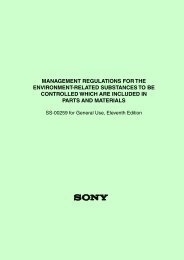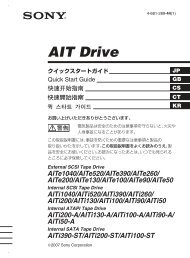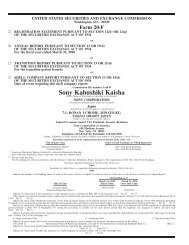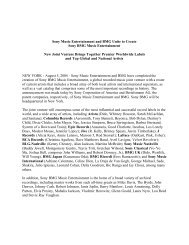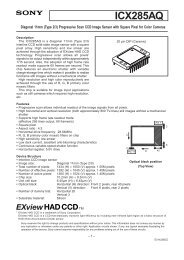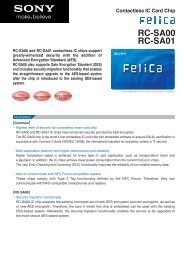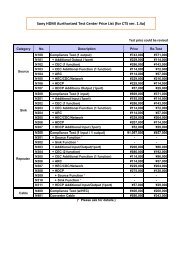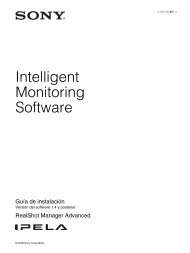PDF [4833KB] - Sony
PDF [4833KB] - Sony
PDF [4833KB] - Sony
Create successful ePaper yourself
Turn your PDF publications into a flip-book with our unique Google optimized e-Paper software.
unforeseen changes in business assumptions<br />
could negatively affect the valuations of those<br />
long-lived assets. These unforeseen changes<br />
include a possible further decline in demand for<br />
TV display CRTs due to a shift in demand from<br />
CRT displays to LCD and plasma panel displays.<br />
In the year ended March 31, 2003, <strong>Sony</strong><br />
recorded impairment charges for long-lived<br />
assets totaling 12.4 billion yen. It included 8.1<br />
billion yen for the impairment of semiconductor<br />
and computer display CRT manufacturing<br />
equipment to be abandoned or to be sold in<br />
connection with certain restructuring activities<br />
in the Electronics segment. It also included 2.7<br />
billion yen for the impairment of a CD manufacturing<br />
facility in the U.S., the fair value of<br />
which was estimated by using methods such<br />
as a survey of the local real estate market.<br />
In the year ended March 31, 2004, <strong>Sony</strong><br />
recorded impairment charges for long-lived<br />
assets totaling 16.1 billion yen. It included 5.3<br />
billion yen for the impairment of long-lived<br />
assets such as semiconductor and TV display<br />
CRT manufacturing equipment to be abandoned<br />
or sold in connection with certain<br />
restructuring activities in the Electronics<br />
segment. It also included 3.0 billion yen for<br />
the impairment of long-lived assets in Music<br />
segment including a certain CD manufacturing<br />
facility to be abandoned or sold and a<br />
recording studio and equipment to be held<br />
and used in Japan. Fair value of these assets<br />
is determined using estimated future discounted<br />
cash flows which are based on the<br />
best information available.<br />
GOODWILL AND OTHER INTANGIBLE ASSETS<br />
Goodwill and other intangible assets that are<br />
determined to have an indefinite life are not<br />
amortized, but are tested for impairment in<br />
accordance with FAS No. 142 on an annual<br />
basis and between annual tests if an event<br />
occurs or circumstances change that would<br />
more likely than not reduce the fair value of<br />
these assets below their carrying value. Such<br />
an event would include unfavorable variances<br />
from established business plans, significant<br />
changes in forecasted results or volatility inherent<br />
to external markets and industries, which<br />
are periodically reviewed by management.<br />
Specifically, goodwill impairment is determined<br />
using a two-step process. The first step of the<br />
goodwill impairment test is used to identify<br />
potential impairment by comparing the fair<br />
value of a reporting unit (<strong>Sony</strong>’s operating<br />
segments or one level below the operating<br />
segments) with its carrying amount, including<br />
goodwill. If the fair value of a reporting unit<br />
exceeds its carrying amount, goodwill of the<br />
reporting unit is considered not impaired and<br />
the second step of the impairment test is<br />
unnecessary. If the carrying amount of a reporting<br />
unit exceeds its fair value, the second step<br />
of the goodwill impairment test is performed to<br />
measure the amount of impairment loss, if any.<br />
The second step of the goodwill impairment<br />
test compares the implied fair value of the<br />
reporting unit’s goodwill with the carrying<br />
amount of that goodwill. If the carrying amount<br />
of the reporting unit’s goodwill exceeds the<br />
implied fair value of that goodwill, an impairment<br />
loss is recognized in an amount equal to<br />
that excess. The implied fair value of goodwill is<br />
determined in the same manner as the amount<br />
of goodwill recognized in a business combination.<br />
That is, the fair value of the reporting unit<br />
is allocated to all of the assets and liabilities of<br />
that unit (including any unrecognized intangible<br />
assets) as if the reporting unit had been acquired<br />
in a business combination and the fair<br />
value of the reporting unit was the purchase<br />
price paid to acquire the reporting unit. Other<br />
intangible assets are tested for impairment by<br />
comparing the fair value of the intangible asset<br />
with its carrying value. If the carrying value of<br />
the intangible asset exceeds its fair value, an<br />
impairment loss is recognized in an amount<br />
equal to that excess.<br />
Determining the fair value of a reporting<br />
unit under the first step of the goodwill impairment<br />
test and determining the fair value of<br />
individual assets and liabilities of a reporting<br />
unit (including unrecognized intangible assets)<br />
under the second step of the goodwill impairment<br />
test is judgmental in nature and often<br />
involves the use of significant estimates and<br />
assumptions. Similarly, estimates and assumptions<br />
are used in determining the fair value of<br />
other intangible assets. These estimates and<br />
assumptions could significantly impact whether<br />
or not an impairment charge is recognized as<br />
well as the magnitude of any such charge. In<br />
its impairment review, <strong>Sony</strong> performs internal<br />
valuation analyses or utilizes third-party<br />
valuations when management believes it to be<br />
appropriate, and considers other market information<br />
that is publicly available. Estimates of<br />
fair value are primarily determined using discounted<br />
cash flow analysis. This approach uses<br />
significant estimates and assumptions including<br />
projected future cash flows, the timing of<br />
such cash flows, discount rates reflecting the<br />
risk inherent in future cash flows, perpetual<br />
growth rates, determination of appropriate<br />
market comparables and the determination of<br />
whether a premium or discount should be<br />
applied to comparables. During the year ended<br />
March 31, 2004, <strong>Sony</strong> recorded a charge for<br />
the impairment of goodwill of 6.0 billion yen<br />
in the Electronics segment. This impairment<br />
charge reflected the overall decline in the fair<br />
value of a subsidiary within the Electronics<br />
segment. The fair value of that reporting unit<br />
was estimated principally using the expected<br />
present value of future cash flows utilizing a<br />
third party valuation.<br />
Management believes that the estimates of<br />
future cash flows and fair value are reasonable;<br />
however, changes in estimates resulting<br />
in lower future cash flows and fair value due to<br />
unforeseen changes in business assumptions<br />
could negatively affect the valuations, which<br />
may result in <strong>Sony</strong> recognizing impairment<br />
charges for goodwill and other intangible<br />
assets in the future. As of March 31, 2004, a<br />
10 percent decrease in the fair value of each<br />
of <strong>Sony</strong>’s reporting units would not have<br />
resulted in a material impairment charge.<br />
PENSION BENEFITS COSTS<br />
Employee pension benefit costs and obligations<br />
are dependent on certain assumptions including<br />
discount rates, retirement rates and mortality<br />
rates, which are based upon current statistical<br />
data, as well as expected long-term rates of<br />
return on plan assets and other factors. Specifically,<br />
the discount rate and expected long-term<br />
rate of return on assets are two critical assumptions<br />
in the determination of periodic pension<br />
costs and pension liabilities. Assumptions are<br />
evaluated at least annually and when events<br />
occur or circumstances change which could<br />
have a significant effect on these critical assumptions.<br />
In accordance with U.S. GAAP, actual<br />
results that differ from the assumptions are<br />
accumulated and amortized over future periods.<br />
85


![PDF [4833KB] - Sony](https://img.yumpu.com/26420643/87/500x640/pdf-4833kb-sony.jpg)
